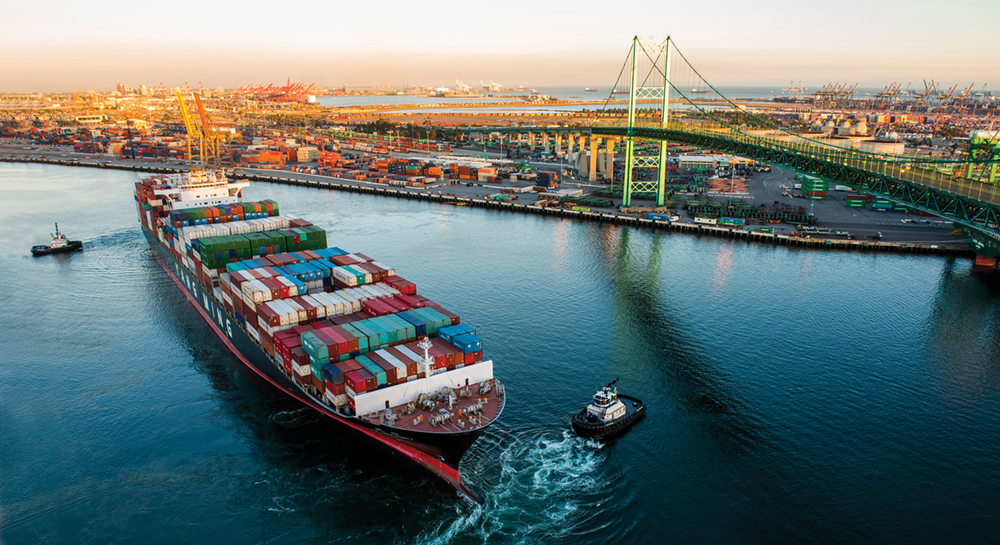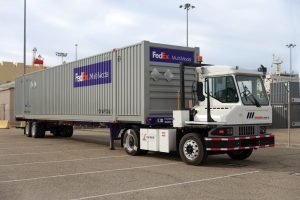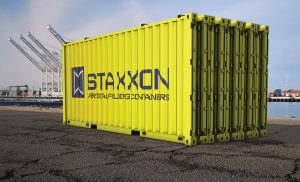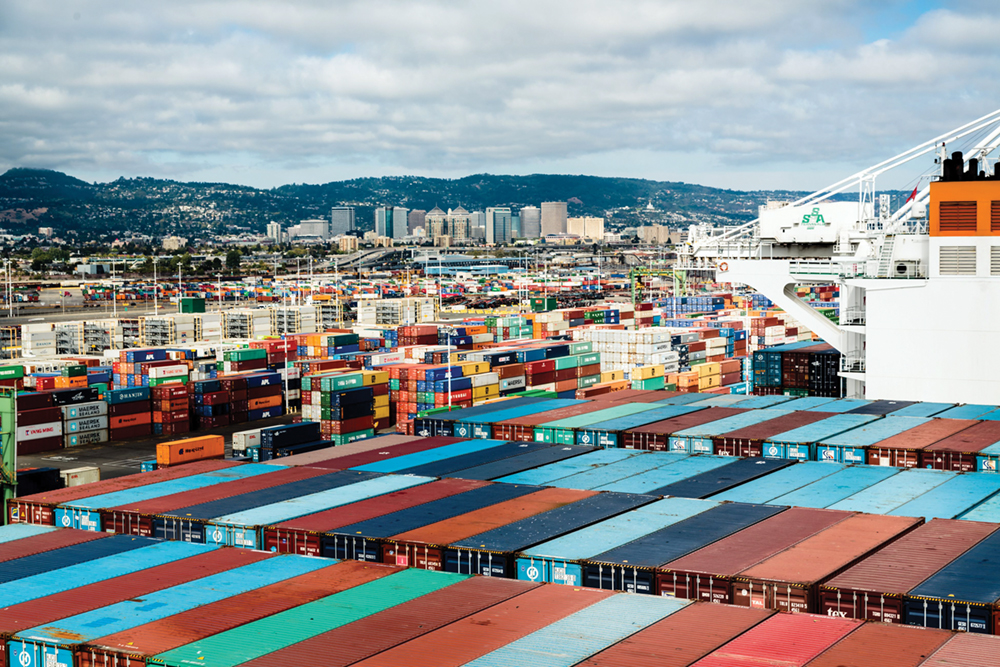
For the past two years, West Coast cargo congestion has dominated headlines as dozens of vessels at anchor wait to come into seaports and stacks of containers linger at terminals, exposing an already fragile supply chain.
The congestion problem — which stemmed from the pandemic-driven cargo volumes that shattered records last year — caught the attention of the federal government, which announced it is prioritizing strengthening the supply chain with billions of dollars of investment in port and waterway infrastructure.
While consumer demand has slowed a bit from last year’s record pace of goods flowing into U.S. ports, it nonetheless remains strong, and a backlog of containers still needs to be cleared.
According to the Pacific Merchant Shipping Association, the average dwell time for containers at the ports of Los Angeles and Long Beach in April was 6.09 days for an import leaving by truck and 9.6 days for a container leaving by rail.
“Prior to July 2020 containers remained on terminals for about three days and that’s what we hope to get back to,” said Jessica Alvarenga, PMSA’s manager of government affairs.
Other factors, such as the recent uptick in COVID-19 cases, the closure of factories and ports in China to prevent the spread of COVID-19 and the resulting effects to ocean-carrier scheduling, threaten to derail cargo flow.
Here’s a look at how congestion is impacting some U.S. and Canadian West Coast seaports and how the industry is trying to think more dynamically about the way they move containers.
PORT OF LOS ANGELES
As the nation’s busiest seaport, the Port of L.A. has been dealing with cargo congestion first-hand, trying to process record import volumes in a global pandemic.
Executive Director Gene Seroka addressed the state of his port at a media briefing in May, saying that cargo is still finding its way out of ports throughout central China, despite worries that recent COVID-19 lockdowns threaten to affect cargo moving across the Pacific.
“So far, we’ve seen no dramatic change in the number of vessels leaving China since the lockdowns went into effect in Shanghai some six weeks ago,” Seroka said. “Cargo moving out of the Yangshan Deep Seaport, which is traditional now for long-leg international, continues to move at a good pace.”
He also said that he’s seen the Port of Ningbo-Zhoushan picking up the slack as lockdowns have affected the fluid movement of cargo out of central China, and that San Pedro Bay has been seeing a consistent number of cargo vessels arriving from Asia.
“While there are impacts being seen from some assembly to manufacturing through delivery in central China, trans-Pacific trade is holding steady, although conditions could change,” he remarked. “I don’t see a bust coming any time soon. More likely … we may see a lull in volume with a fairly quick bounce back when the lockdowns end.”
Meanwhile, Los Angeles continues to work through the backlog. For ship staging at the 150-mile marker, the port has reduced the number of ships at anchor from a peak of 109 ships in January to 35 ships in May.
“There’s still much more work to do, but (it’s) very encouraging,” Seroka said.
Los Angeles is also working through lingering rail-bound cargo.
As of May, there were 18,500 to 19,000 containers waiting to leave by rail, more than double the 9,000 containers that Los Angeles typically sees on its docks, Seroka said.
“We need to redouble our efforts to maximize cargo flow off our docks and into the domestic economy,” he said, adding that “rail-bound cargo has increased sixfold over the last two months and is not moving off our terminals fast enough.”
“Simply put, we need more rail assets in place,” Seroka said.
The Biden-Harris administration has been holding stakeholder meetings on the matter. The federal Surface Transportation Board is also focused on improving intermodal service, saying that “fewer rail workers, combined with a spike in volume, has significantly hampered service,” Seroka said.
“Our team here in Los Angeles is working diligently with the railroads, terminal operators, carriers and the administration on a range of solutions to improve this critical node of the supply chain,” he added.
Data has played a major role in managing cargo flow, Seroka explained.
“The ability to take a look at trending, see around corners and over hills before problems happen has been a hallmark of that data that we put together so far,” he said.
About 53% of available truck gates in Los Angeles go unused daily, according to port data.
“We’ve got to do a better job of using that capacity … so that truckers can come in and out quickly and ensure that our importers are picking up their cargo (in a) timely (manner),” Seroka said.
“We know a lot more than we did two years ago, even more than a year ago, but we still have to keep mining this data, working with our partners and trying to grab every type of efficiency gain that we can to manage all of this cargo.”
EXPORT PAIN POINTS
Cargo congestion has had an impact on export business at West Coast seaports, especially at the Port of Oakland and the Northwest Seaport Alliance ports of Seattle and Tacoma.
At the Port of Oakland, a major gateway to Asia for U.S. exports such as agricultural goods, overall cargo volumes in April dropped 7% from the same time last year, according to port data released in May.
In April, imports tumbled 17% and exports fell 18% year over year, a result of fewer ships arriving in Oakland and importers not picking up their shipments quickly enough, which has created a shortage of available containers for exporters.
Bottlenecks at West Coast seaports and a COVID-19-related port closure in Shanghai also played a role in reduced cargo numbers, the port said.
“Supply-chain issues locally to globally have hampered the U.S. export business through West Coast ports, including Oakland,” Port Executive Director Danny Wan said.
Fewer ship calls also resulted in reduced export business for Oakland, which is working with exporters – especially agricultural exporters – to locate more space on vessels and more containers to move goods overseas.
One effort includes a new 25-acre pop-up storage yard for containers that opened off terminal March 7.
To encourage agricultural and other exporters to use the yard, the U.S. Department of Agriculture is offering to help reimburse costs for using the yard. The USDA is providing $400 per refrigerated export container and $200 per non-reefer box, as well as a $125 incentive to pick up empties for agricultural bookings, the port said.
“This will help defray the additional costs incurred by our shippers and make usage of the new facility more feasible,” port Maritime Director Bryan Brandes said. “The temporary yard provides a place for truckers to easily pick up empty containers to be loaded with U.S. exports and it allows for staging loaded containers ready to be shipped overseas without crowding busy terminals.”
The Agriculture Department is teaming up with the Northwest Seaport Alliance on a similar effort to bolster access to a 49-acre temporary storage area in Seattle for dry agricultural and reefer containers.
Area agricultural exporters have been having a tough time shipping their products because congestion issues have affected ship schedules and the need to prioritize sending empties back to Asia to refill with goods has resulted in fewer available containers.
In the second half of 2021, the NWSA saw close to a 30% drop-off in the export of agricultural goods, and the share of loaded containers and empties has leaned mainly to empties since May 2021, according to the Alliance.
“Over the past year, the Northwest Seaport Alliance has been working closely with ag exporters to help mitigate supply-chain challenges,” said NWSA co-chair and Port of Seattle Commission President Ryan Calkins, adding that this pilot program lowers costs for agricultural producers and helps bring more U.S. exports to foreign markets.
The Seaport Alliance has opened over 60 acres of near-dock storage to lower port congestion and raise export opportunities, said NWSA Managing Member and Port of Tacoma Commission Vice President Deanna Keller.
“The partnership with the USDA will further our efforts and provide needed relief for ag producers in our region,” Keller said.

PORT OF HUENEME
As one of the closest seaports to Los Angeles and Long Beach, the Port of Hueneme has been the recipient of much of the overflow that’s been jamming up cargo flow at the twin ports.
Located about 84 miles north of LA-Long Beach by car, the Port of Hueneme has been working to accommodate the additional cargo.
Last November, the port and Naval Base Ventura County (NBVC)—which is made up of three operational facilities: Point Mugu, Port Hueneme and San Nicolas Island—enacted a long-standing joint-use agreement that would authorize the use of naval resources to help ease bottlenecks in Los Angeles County.
The agreement allows for the commercial use of a wharf onboard the naval base, including roughly “21 acres of contiguous land, buildings 546 and 548, and if available, up to an additional 10 acres of industrial land located outside of the Wharf 3 area,” according to the port.
The base recently welcomed a cargo ship from Ports America, which unloaded a number of containers into Lot 22 onboard Port Hueneme, goods that were expected to directly support holiday supply demands, said Daniel J. Herrera, assistant program director for port operations at NBVC.
In January, the port announced it secured a new charter vessel with FedEx Logistics. With enough room for 300 53-foot containers per sailing, the first vessel of FedEx containers arrived in late January from Port of Humen, China, the first in a series of several chartered vessels set to arrive this year, More arrivals are in the works over the next year depending on the success of these initial services, according to the port.
FedEx has its own chassis, allowing for expedited departure to distribution centers.
“FedEx Logistics is thrilled to collaborate with everyone at Port of Hueneme as we put our collective strength and expertise together to create a value-added solution for our customers, while helping to alleviate pressure at the ports of Long Beach and Los Angeles,” FedEx Logistics President and CEO Udo Lange said.
Thanks to the newly activated agreement with NBVC, the cargo was able to be staged initially on Navy property so it didn’t disrupt the port’s existing services.
“At the Port of Hueneme, we take these challenges and turn them into opportunities,” said CEO and Port Director Kristin Decas. “When we make cargo move, we can do our part to alleviate congestion at other West Coast ports and get important products into the hands of U.S. consumers.”
BRITISH COLUMBIA
America’s West Coast seaports aren’t the only ones feeling the pinch.
As if dealing with pandemic-driven supply-chain challenges wasn’t enough, severe flooding in British Columbia in mid-November shut down rail service linking the Port of Vancouver to Canada’s distribution points for eight days. To provide some relief, the Vancouver Fraser Port Authority in late February announced the development of a temporary storage area in Richmond for empty containers.
Logistics company Coast2000 Terminals and Euro Asia Transload were selected to run the temporary site, which is expected to stay in operation until July.
“As partners throughout the Port of Vancouver continue work(ing) to clear supply-chain backlogs in the wake of November’s flooding, this new container storage site adds valuable capacity to support activities at Canada’s largest port, which in turn supports local and national supply chains,” said Robin Silvester, president and CEO of the Vancouver Fraser Port Authority.
Meanwhile, officials at Port of Prince Rupert, Canada’s third-largest port, are planning to add capacity and protection against supply-chain constraints.
“Disruptions and congestion experienced during the past year in southern British Columbia and other West Coast supply chains have accentuated the need for additional capacity in Prince Rupert,” according to the Port Authority representatives.
The Prince Rupert Port Authority and logistics company DP World in February announced updates to various infrastructure projects, including the expansion of Fairview Container Terminal, which is expected to bolster capacity to 1.6 million TEUs (twenty-foot equivalent units) this summer and 1.8 million TEUs in 2024. Phase One is now halfway finished and is expected to be completed in July. Phase Two is set to be finished in late 2024.
“(T)his expansion of the Prince Rupert Gateway will provide the infrastructure necessary to meet increasing trade growth forecasts,” DP World (Canada) CEO and General Manager Maksim Mihic explained. “The Fairview Phase 2B expansion sets Prince Rupert firmly on the path to becoming a leading strategic Canadian logistics hub, custom-built for high-volume intermodal traffic.”
The port, DP World and Ray-Mont Logistics are also moving forward on efforts to add transloading and warehousing capacity with a new, modern export logistics facility on Ridley Island. Served by rail, the facility would provide an opportunity to expand Prince Rupert’s capacity to box and ship major Canadian commodities, including grains, resins, pulp and lumber, port officials said.
On the import side, the port and the Metlakatla Development Corp. are working on the development of the South Kaien Import Logistics Facility on 34 acres near the Fairview Container Terminal. It is expected to integrate into Prince Rupert Gateway’s logistics hub, a vital part of the port’s plan for future growth by 2030.
TECH SOLUTIONS
In recent years, technology has been touted as a solution for a maritime industry, with various tech firms coming online to offer ways to make the supply chain more efficient.
But Seattle-based terminal operating systems software provider Tideworks Technology saw the advantage early, launching in 1999 after four decades as a division of technology for cargo terminal operator Carrix, Inc.
“Moving from the days when it was paper and clipboards in the gate lanes to technology was mission critical,” Tideworks Vice President of Business Development Todd Tatterson said.
Currently, more than 120 facilities use Tideworks’ systems for a variety of functions, from loading trains and ships to locating containers. On the West Coast, Tideworks supports more than a dozen marine container terminals, as well as multiple North American Class I railroads.
“Our roots are operational,” Tatterson said. “We realized technology can add value to our customers’ operations, but we never throw technology at a problem unless it does add value. We’re not there simply to sell software and walk away. We truly partner with our clients, whether it’s SSA Marine and Carrix or any third party.”
Tideworks is learning more from its customers about recent congestion woes.
“We’re hearing that port congestion is a total supply-chain issue, rather than just the result of port operations,” Tideworks Vice President Hugh Gallagher said. “Things like consumer demand, shortages of labor and equipment, global-trade type constraints resulting from the pandemic are really driving what we see as record-breaking container volumes. It’s nuanced. It’s hard to isolate one single cause.”
Tatterson echoed the sentiment.

“(T)he terminal operators, our clients, have definitely faced some very unique challenges in the last couple of years with an unanticipated surge, the change in chassis ownership and all this going on in the world,” Tatterson said. “What we would like to offer is a productive, collaborative voice at the table.”
And Tideworks is doing just that. Company president Thomas (TJ) Rucker is part of the Federal Maritime Commission’s Maritime Transportation Data Initiative, which is working to pinpoint gaps in data definitions and classifications and develop recommendations for standards, policies and procedures.
“As a software and technology provider serving the broad supply chain, whether it be marine terminals or railroads in North America, we’re an active participant trying to help our clients remove friction from any part of their operation where it may be bottlenecked,” Tatterson said. “We would like to be a voice, be an active participant and continue to listen and assist our clients.”
Meanwhile, New Jersey-based company Staxxon is bringing its folding container technology to the West Coast. Two companies in the Pacific Northwest signed on as trial participants and exporters in Hawaii have been in contact with Staxxon about the accordion-style container that can fold to one-fifth the size of a full container. Staxxon declined to name the West Coast companies for confidentiality reasons.
“The shipping container today is essentially the same container from 60 years ago when the container ship industry began worldwide, so there hasn’t been a lot of innovation in the container itself,” Staxxon co-founder and CFO Richard Danderline said. “It’s really been seen as just a commodity and a means to an end, and no one has really focused on it. One of the things that all of the recent shipping crises has shown is that the container is actually a very, very important part of the process.”
KAREN ROBES MEEKS, A SOUTHERN CALIFORNIA NATIVE, is an award-winning journalist with more than 20 years’ writing experience. Her articles have appeared in the Los Angeles Times, San Francisco Chronicle, Orange County Register and Long Beach Press-Telegram, where she worked as a reporter for nearly 14 years. Her work has been recognized by the California News Publishers Association, the Associated Press News Executives Council and the Los Angeles Press Club.

